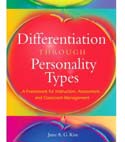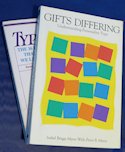
- About the MBTI
- Verify Your MBTI Type
- Personality Patterns
- MBTI Articles & Resources
- Article Directory for Educators & Students
- Books on Personality Types
- Emotional Intelligence & Personality Type
- Career Planning & MBTI
- MBTI Business Applications
- Lenore Thomson - Carl Jung Personality Type
- Site Map - Master Directory of All Articles
- MBTI Consultant Links
- Personality Type Workshops & Conferences
- Links to Other Type Websites
- Murder Mystery Business Theatre
- About Us
| 1 | 2 | 3 |
Articles on MBTI ® applications: Personality Type Applications in Education
Are They Really Problem Students? Bridging Differences through Understanding
By Jane Kise, Ed. D., and Beth Russell, Ed. D.
(jane kise' preferences are infj; beth russell's are enfj)
Page 2 . . .
The Importance of Personality Preferences in the classroom
Think of these personality preferences as similar to the inclination you have for writing with your left or right hand. Writing with your preferred hand is more natural and comfortable, and it takes less energy and thought. With practice, though, you could write well with the other hand.
|
Similarly, students are most comfortable when they can use their learning preferences. Even though they can learn to operate outside of their preferences, it takes more effort, which can hamper their learning. Without an understanding of the differences, Lamphere (1985) showed that teachers tend to rate more favorably students with learning styles similar to their own.
When the teachers start to understand the behavior of students with different personalities, they can adjust the structure and flow of their classrooms to allow for success for more students. This shift in teacher attitude toward students of color is crucial, given the prevalence among educators of the “deficit model” for children of color, where their cultural differences are viewed as problems to be overcome rather than diversity that can be drawn upon. (Lipman, 1998)
In staff workshops, we give teachers new to the MBTI tool a chance to take the instrument, but they are also allowed to self-select the preferences that fit them best through interactive exercises. The MBTI is only an “indicator”; ethically, those who take it need to experience an interactive interpretation.
In working with students, we emphasize self-discovery and understanding the differences between the preferences. Students are allowed to stay undecided as to which preferences describe them best. The eight preferences and their implications for learning are discussed below.
Extraversion and Introversion
Type theory holds that people gain energy through either Extraversion or Introversion. At school, students with a preference for Extraversion need action and interaction to learn. Students with a preference for Introversion learn best when they have time for reflection.
When asked to design an ideal classroom, Extraverts draw moveable walls, chairs on wheels, a table big enough to accommodate chairs for up to 50 students, areas for playing games, and music. Further, the noise level of the group increases as they work together on the design.
Introverts draw classrooms with seven to ten students. Their designs often show individual desks with laptop computers and comfortable places for reading. The introverted students (or teachers) often quietly huddle together as they work on this project, giving a few words of direction to the designated drawer. They say, “It’s nice to work in this group. Usually the others blurt things out so fast that we don’t get a chance.”
With the concrete evidence of these drawings in front of them, both teachers and students begin to understand the differing needs of Extraverts and Introverts. At a basic level, silent reading and writing activities favor the Introverted students; to gain energy for those tasks, Extraverts need breaks to talk or move.
To understand the difference in “think time” required by Extraverts and Introverts, one teacher asked her 8th grade social studies class to place a green card on their desk when they were ready to discuss the topic at hand. She said, “I was very surprised that it took some students as long as 10 minutes to process the information. But then, everyone contributed to the discussion. I could call on anyone! I heard from students who don’t normally say a word.”
Sensing and Intuition
Our preference for Sensing or Intuition describes how we take in information. Students with a preference for Sensing like to start with factual information before moving to broader concepts. Students with a preference for Intuition often start with a hunch or a glimpse of how two ideas connect, later searching for facts to support their ideas.
In a classroom, the differences between Sensing and Intuition become clear in the way directions are given and received. An art teacher noted that her Sensing students enjoyed the realistic drawing unit, with its step-by-step processes, details, rules, and proportional logic. In contrast, many of the Intuitive students found the unit frustrating. She said, “I reminded my classes of the difference between Sensing and Intuition, then described why and how to be less frustrated. The level of concentration went way up! It was a noticeable difference from their previous work habits.”
Sensing students ask questions to clarify assignments. They don’t want to waste time doing anything wrong. A teacher who doesn’t understand the drive behind the questions may feel that a student is stalling or refusing to take initiative. Sensing students describe their frustrations this way:
- “I didn’t understand the math homework. The teacher helped me with one problem, but I still didn’t get it and she passed me over. She could have showed more examples. How was I supposed to know?”
- “It’s frustrating because they label you. ‘You don’t get it? Sound it out, look it up!’ That’s intimidating.”
Intuitives often ask their questions five minutes after a teacher has finished giving directions—and the teachers often rightly say that the student would know the answer if he or she had been listening. One Intuitive student explained why he hadn’t heard this way, “When she said that we were going to write reports on someone who had influenced us, I started trying to think of someone that no one else would think of. I missed the rest of the directions.”
Providing written instructions saves frustration for the teacher. One teacher described another technique, “I now give directions in short ‘bursts,’ provide a checklist for large assignments, then clarify as the questions come in. The Intuitives are then free to start working, as I now understand they will do anyway!”
Intuitive teachers often struggle to give concise directions and admit that their last group of students benefit from clarifications the first groups asked for. One Intuitive teacher said, “I love coming up with the cool and creative thing that students will engage in most, but I have to realize that no matter how cool and creative it might be, it may be equally frustrating if my directions aren’t clear. I need to spend time clarifying the process.”
> > > Next Page: Learning Needs of Thinking and Feeling Students
® MBTI, Myers-Briggs, Meyers Briggs, and Myers-Briggs Type Indicator are registered trademarks or trademarks of the Myers-Briggs Type Indicator Trust in the United States and other countries (aka meyers briggs or myers briggs).
Quiet: The Power of Introverts in a World That Can't Stop Talking
Susan Cain has written a best-selling book on the barriers introverts face in a world dominated by extraversion with advice for introverts and extraverts alike for how to make best use of the skills and perspectives that introverts bring to our communities, to relationships, and the working world. This book covers only one aspect of Personaltiy Type, Introversion and Extraversion, however, this is the most widely recognized and perhaps most powerful dimension of Jung's theory of Personality Types.
© Published by Ross Reinhold & Reinhold Development 1997 - 2023
Privacy Policy About Us




